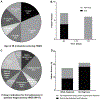Rapid Whole Genome Sequencing Has Clinical Utility in Children in the PICU
- PMID: 31246743
- PMCID: PMC6832787
- DOI: 10.1097/PCC.0000000000002056
Rapid Whole Genome Sequencing Has Clinical Utility in Children in the PICU
Abstract
Objectives: Genetic disorders are a leading contributor to mortality in the neonatal ICU and PICU in the United States. Although individually rare, there are over 6,200 single-gene diseases, which may preclude a genetic diagnosis prior to ICU admission. Rapid whole genome sequencing is an emerging method of diagnosing genetic conditions in time to affect ICU management of neonates; however, its clinical utility has yet to be adequately demonstrated in critically ill children. This study evaluates next-generation sequencing in pediatric critical care.
Design: Retrospective cohort study.
Setting: Single-center PICU in a tertiary children's hospital.
Patients: Children 4 months to 18 years admitted to the PICU who were nominated between July 2016 and May 2018.
Interventions: Rapid whole genome sequencing with targeted phenotype-driven analysis was performed on patients and their parents, when parental samples were available.
Measurements and main results: A molecular diagnosis was made by rapid whole genome sequencing in 17 of 38 children (45%). In four of the 17 patients (24%), the genetic diagnoses led to a change in management while in the PICU, including genome-informed changes in pharmacotherapy and transition to palliative care. Nine of the 17 diagnosed children (53%) had no dysmorphic features or developmental delay. Eighty-two percent of diagnoses affected the clinical management of the patient and/or family after PICU discharge, including avoidance of biopsy, administration of factor replacement, and surveillance for disorder-related sequelae.
Conclusions: This study demonstrates a retrospective evaluation for undiagnosed genetic disease in the PICU and clinical utility of rapid whole genome sequencing in a portion of critically ill children. Further studies are needed to identify PICU patients who will benefit from rapid whole genome sequencing early in PICU admission when the underlying etiology is unclear.
Figures



Comment in
-
Rapid Whole Genome Sequencing and Fulfilling the Promise of Precision Pediatric Critical Care.Pediatr Crit Care Med. 2019 Nov;20(11):1085-1086. doi: 10.1097/PCC.0000000000002082. Pediatr Crit Care Med. 2019. PMID: 31688677 Free PMC article. No abstract available.
References
-
- Online Mendelian Inheritance in Man. McKusick-Nathans Institute of Genetic Medicine, Johns Hopkins University; Baltimore, MD: available at www.omim.org/statistics [accessed 21 June 2018]
-
- March of Dimes Foundation Data Book for Policy Makers. Maternal, Infant, and Child Health in the United States 2016. http://www.marchofdimes.org/March-of-Dimes-2016-Databook.pdf. Accessed 27 May 2016.
-
- Kochanek KD, Murphy SL, Xu J, Arias E. Mortality in the United States, 2016. NCHS Data Brief. 2017;293:1–8Khokha MK, Mitchell LE, Wallingford JB. White paper on the study of birth defects. Birth Defects Res 2017; 109:180–185

